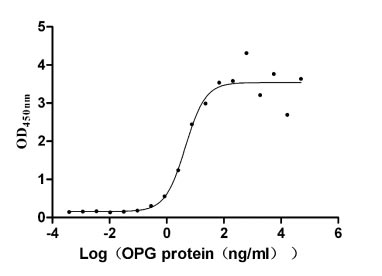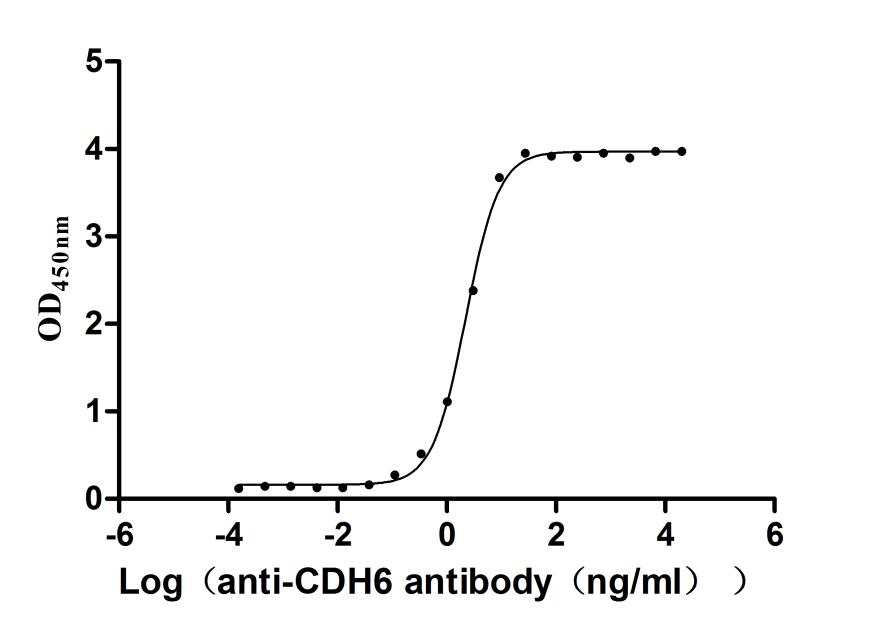Recombinant Human C-C motif chemokine 15 (CCL15)
-
货号:CSB-YP614984HU
-
规格:
-
来源:Yeast
-
其他:
-
货号:CSB-EP614984HU
-
规格:
-
来源:E.coli
-
其他:
-
货号:CSB-EP614984HU-B
-
规格:
-
来源:E.coli
-
共轭:Avi-tag Biotinylated
E. coli biotin ligase (BirA) is highly specific in covalently attaching biotin to the 15 amino acid AviTag peptide. This recombinant protein was biotinylated in vivo by AviTag-BirA technology, which method is BriA catalyzes amide linkage between the biotin and the specific lysine of the AviTag.
-
其他:
-
货号:CSB-BP614984HU
-
规格:
-
来源:Baculovirus
-
其他:
-
货号:CSB-MP614984HU
-
规格:
-
来源:Mammalian cell
-
其他:
产品详情
-
纯度:>85% (SDS-PAGE)
-
基因名:
-
Uniprot No.:
-
别名:C-C motif chemokine 15; C-C motif chemokine ligand 15; CC chemokine 3; CCL15; CCL15(29-92); CCL15_HUMAN; Chemokine (C C motif) ligand 15; Chemokine CC-2; Chemokine CC2; HCC-2; HCC2; HMRP 2B; HMRP2B; Leukotactin 1; Leukotactin-1; LKN-1; LKN1; Macrophage inflammatory protein 5; MIP 1D; MIP-1 delta; MIP-1D; MIP-5; MIP1 delta; MIP1d; MIP5; MRP 2B; Mrp-2b; Mrp2b; NCC 3; NCC-3; NCC3; New CC chemokine 3; OTTHUMP00000163955; SCYA15; SCYL3; Small inducible cytokine A15; Small inducible cytokine subfamily A (Cys Cys); member 15; Small-inducible cytokine A15; SY15
-
种属:Homo sapiens (Human)
-
蛋白长度:Full Length of Mature Protein
-
表达区域:22-113
-
氨基酸序列QFINDAETE LMMSKLPLEN PVVLNSFHFA ADCCTSYISQ SIPCSLMKSY FETSSECSKP GVIFLTKKGR QVCAKPSGPG VQDCMKKLKP YSI
-
蛋白标签:Tag type will be determined during the manufacturing process.
The tag type will be determined during production process. If you have specified tag type, please tell us and we will develop the specified tag preferentially. -
产品提供形式:Lyophilized powder
Note: We will preferentially ship the format that we have in stock, however, if you have any special requirement for the format, please remark your requirement when placing the order, we will prepare according to your demand. -
复溶:We recommend that this vial be briefly centrifuged prior to opening to bring the contents to the bottom. Please reconstitute protein in deionized sterile water to a concentration of 0.1-1.0 mg/mL.We recommend to add 5-50% of glycerol (final concentration) and aliquot for long-term storage at -20℃/-80℃. Our default final concentration of glycerol is 50%. Customers could use it as reference.
-
储存条件:Store at -20°C/-80°C upon receipt, aliquoting is necessary for mutiple use. Avoid repeated freeze-thaw cycles.
-
保质期:The shelf life is related to many factors, storage state, buffer ingredients, storage temperature and the stability of the protein itself.
Generally, the shelf life of liquid form is 6 months at -20°C/-80°C. The shelf life of lyophilized form is 12 months at -20°C/-80°C. -
货期:Delivery time may differ from different purchasing way or location, please kindly consult your local distributors for specific delivery time.Note: All of our proteins are default shipped with normal blue ice packs, if you request to ship with dry ice, please communicate with us in advance and extra fees will be charged.
-
注意事项:Repeated freezing and thawing is not recommended. Store working aliquots at 4°C for up to one week.
-
Datasheet :Please contact us to get it.
相关产品
靶点详情
-
功能:Chemotactic factor that attracts T-cells and monocytes, but not neutrophils, eosinophils, or B-cells. Acts mainly via CC chemokine receptor CCR1. Also binds to CCR3. CCL15(22-92), CCL15(25-92) and CCL15(29-92) are more potent chemoattractants than the small-inducible cytokine A15.
-
基因功能参考文献:
- CCL15 secreted from SMAD4-deficient xenografted human colorectal cancer cells recruited CCR1(+) cells, promoting their metastatic activities to the lung. Lung metastases from colorectal cancer patients revealed that CCL15 expression correlated with loss of SMAD4. CCL15-positive metastases recruited approximately 1.9 times more numbers of CCR1(+) cells than CCL15-negative metastases. PMID: 27492974
- CCL15 activation of CCR1 plays critical roles in hepatocellular carcinoma metastasis. PMID: 26501423
- Orthotopic animal models of HCC were established to investigate the role of CCL15 in hMSCs migration toward HCC in vivo. Both histological and flow cytometric analysis showed that significantly fewer hMSCs localized within 97H-CCL15-shRNA xenografts compared with 97H-green fluorescent protein xenografts after intravenous delivery PMID: 26763650
- Loss of SMAD4 was significantly associated with CCL15 expression. PMID: 26341919
- follicular thyroid carcinoma (FTC) might induce tumor associated macrophages (TAMs) infiltration by producing CCL15. Measurement of TAMs and CCL15 in follicular thyroid lesions may be applied clinically to differentiate FTC from follicular adenoma PMID: 26875556
- two inflammatory cytokines, MIP-1delta and MIP-3alpha, are able to increase mesenchymal stromal cells migration in vitro PMID: 25579056
- we investigated a role of CCL15 in upregulating ICAM-1 in endothelial cells PMID: 23690481
- CCL15 is elevated in human asthma and correlates with disease severity . PMID: 22092970
- Data show that Only three of these proteins EGF, PDGF-BB and MIP-1delta (CCL15) differed significantly in plasma between controls and Alzheimer's disease (AD). PMID: 22279551
- increased secretion by macrophages during Mycobacterium tuberculosis infection PMID: 20016943
- truncation of NH2-terminal amino acid residues increases agonistic potency on CC chemokine receptors 1 and 3 PMID: 11832479
- Lkn-1 activates the ERK pathway by transducing the signal through G(i)/G(o) protein, PLC, PKC delta and Ras, and it may play a role for cell proliferation, differentiation, and regulation of gene expression for other cellular processes PMID: 12759139
- These observations demonstrate that the two NF-kappaB binding sites are essential for phorbol myristate acetate-induced leukotactin-1 (Lkn-1)/CCL15 expression in human monocytes. PMID: 15179048
- CCL15(25-92) has in vitro and in vivo angiogenic activity PMID: 15251437
- alanine-aspartic acid residues preceding the first cysteine at the NH(2)-terminus are essential for the binding and biological activity of leukotactin-1 PMID: 15894113
- Compared with full-length CCL15, proteolytically processed CCL15 isoforms with N-terminal deletions display increased potency to induce calcium fluxes and chemotactic activity on monocytes and to induce adhesiveness of mononuclear cells to fibronectin. PMID: 16034099
- Transcription of the CCL15 gene is regulated by AP-1 and NF-kappaB through MEK and JNK MAPK pathways in monocytoid cells. PMID: 16364464
- Results point to an involvement of the CCL15-CCR1 axis in the pathophysiology of chronic renal failure. PMID: 16737685
- factor NF-kappaB plays an important role in regulation of LZIP expression, and LZIP expression regulates the monocyte cell migration induced by Lkn-1 PMID: 17296613
显示更多
收起更多
-
亚细胞定位:Secreted.
-
蛋白家族:Intercrine beta (chemokine CC) family
-
组织特异性:Most abundant in heart, skeletal muscle and adrenal gland. Lower levels in placenta, liver, pancreas and bone marrow. CCL15(22-92), CCL15(25-92) and CCL15(29-92) are found in high levels in synovial fluids from rheumatoid patients.
-
数据库链接:
HGNC: 10613
OMIM: 601393
KEGG: hsa:6359
STRING: 9606.ENSP00000432034
UniGene: Hs.272493
Most popular with customers
-
Recombinant Human Tumor necrosis factor receptor superfamily member 11B (TNFRSF11B) (Active)
Express system: Mammalian cell
Species: Homo sapiens (Human)
-
Recombinant Human Tissue factor pathway inhibitor (TFPI), partial (Active)
Express system: Mammalian cell
Species: Homo sapiens (Human)
-
Recombinant Mouse Complement component C1q receptor (Cd93), partial (Active)
Express system: Mammalian cell
Species: Mus musculus (Mouse)
-
Recombinant Human Tumor-associated calcium signal transducer 2 (TACSTD2), partial (Active)
Express system: Mammalian cell
Species: Homo sapiens (Human)
-
Recombinant Human Desmoglein-2 (DSG2), partial (Active)
Express system: Mammalian cell
Species: Homo sapiens (Human)
-
Recombinant Human Cell adhesion molecule 1 (CADM1), partial (Active)
Express system: Mammalian cell
Species: Homo sapiens (Human)
-
Recombinant Macaca fascicularis C-type lectin domain family 4 member C(CLEC4C), partial (Active)
Express system: Mammalian cell
Species: Macaca fascicularis (Crab-eating macaque) (Cynomolgus monkey)
-
Recombinant Macaca fascicularis Cadherin 6(CDH6),partial (Active)
Express system: Mammalian cell
Species: Macaca fascicularis (Crab-eating macaque) (Cynomolgus monkey)




















